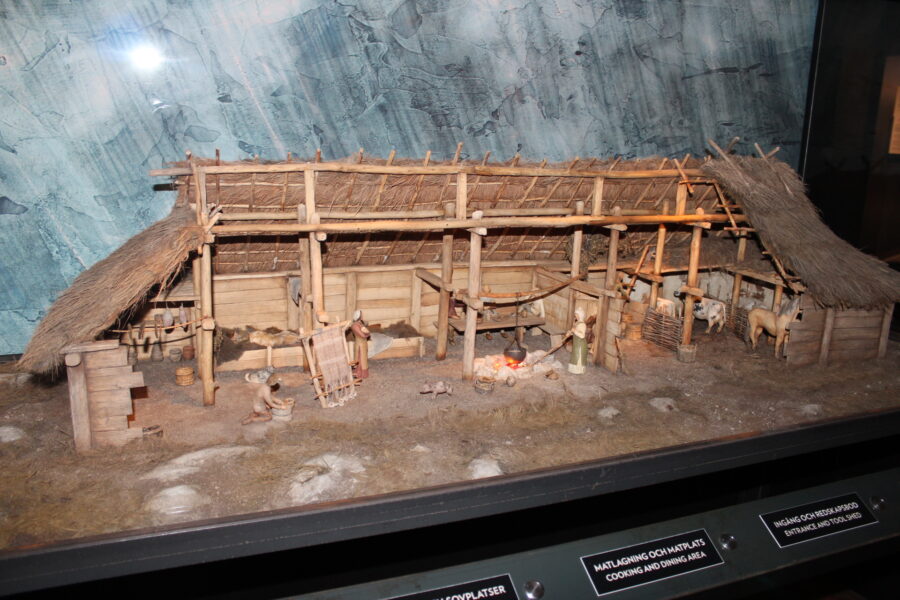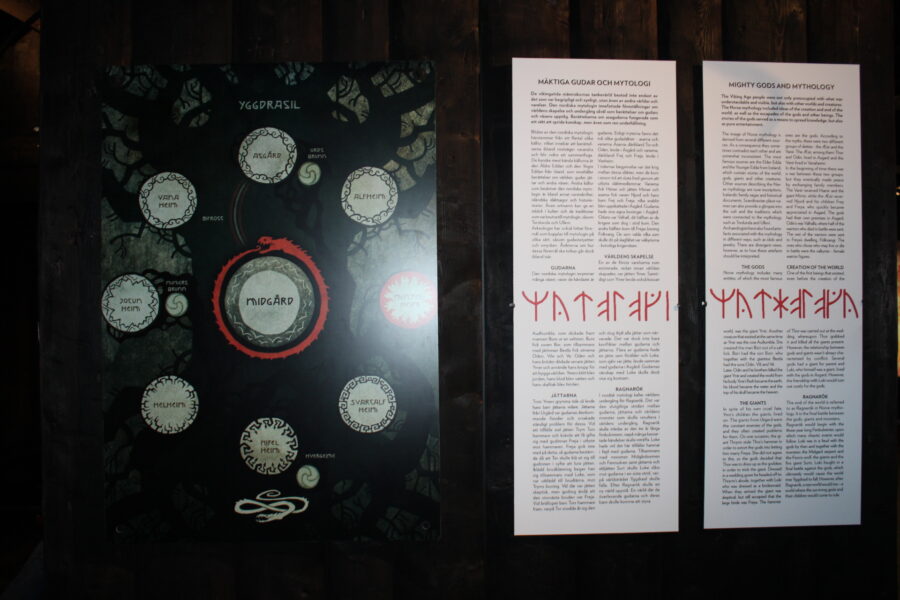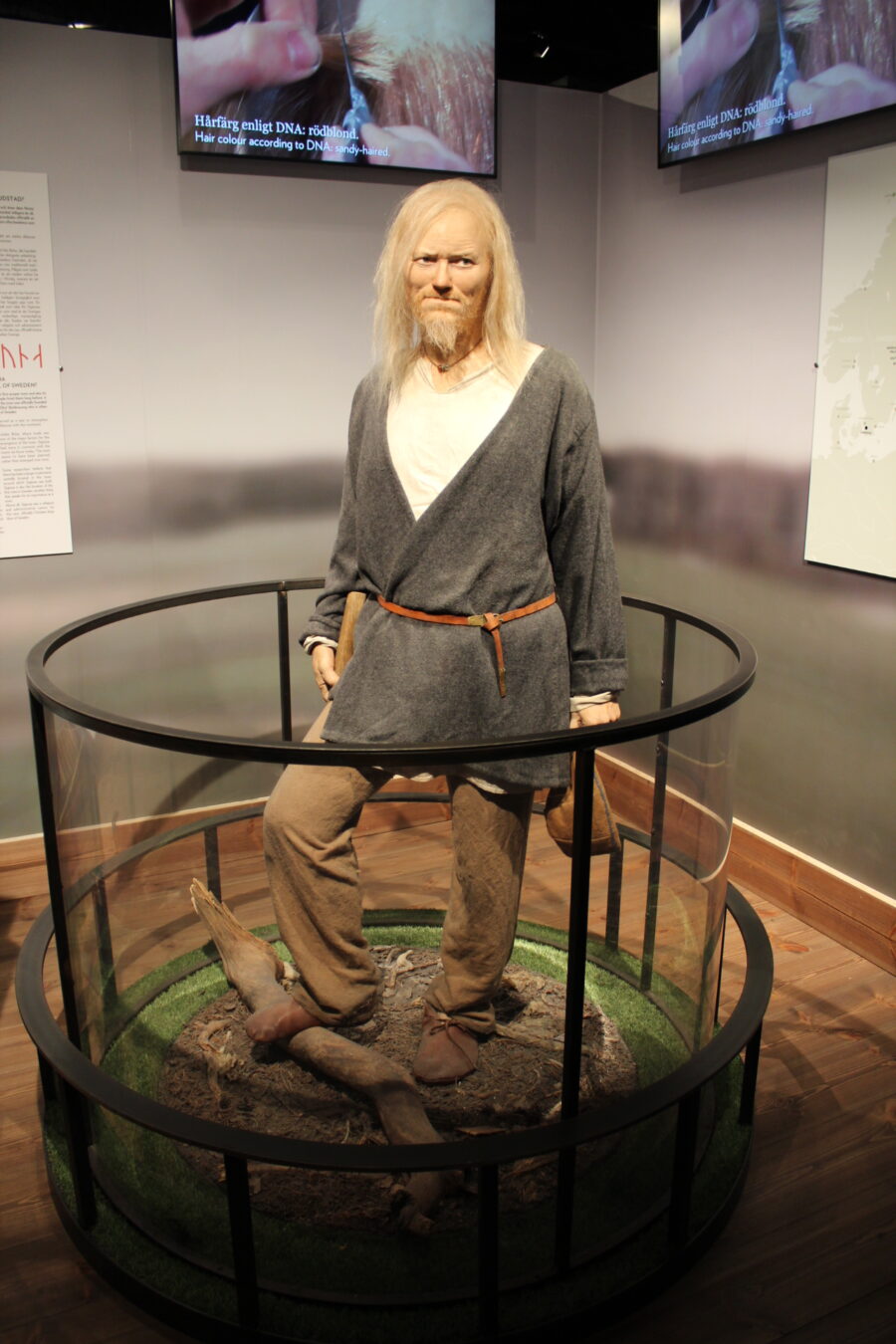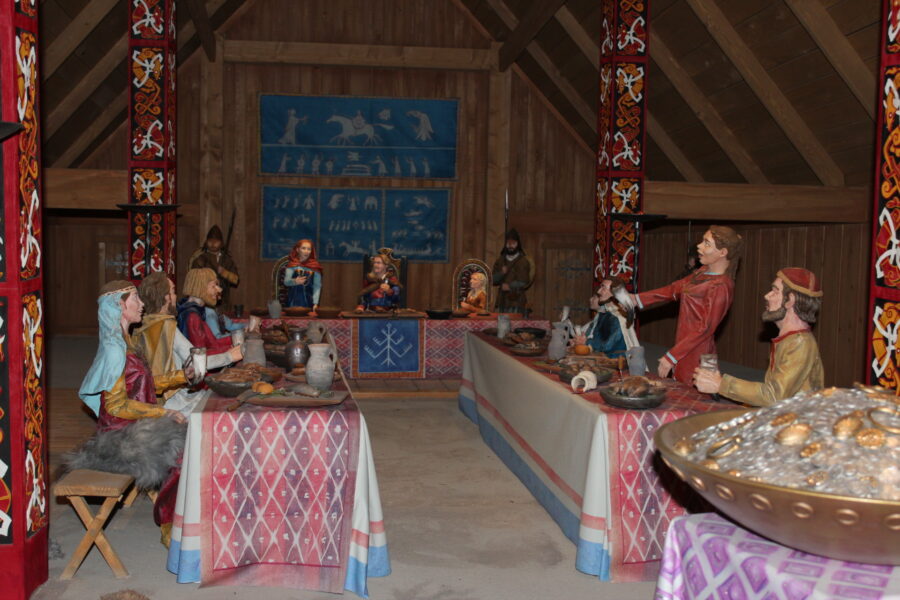Stockholm´s museums: The Viking Museum – tourist info, guides, pictures

NordenBladet – For those, who are interested in Norse mythology and wish to experience the Viking age, I recommend to visit The Viking Museum in Djurgårdsvägen 48, 115 21 Stockholm. In the exhibition, several guided tours are held daily in Swedish and English. Audioguide and adventure ride is available in English, Russian, Finnish, Italian, French, Spanish German, Chinese and Swedish.
In the vivid exhibition you will meet the Vikings through movies, scenery, projections and sound effects as well as archaeological objects. Knowledgeable guides in Viking gear will answer all your questions and the many replicas let you explore life as a Viking with all your senses. You will learn about the Viking raids, journeys and mastery in ship building as well as the everyday life at the farm. The Norse mythology is present everywhere and here myth meets truth.
View this post on InstagramA post shared by NordenBladet (@nordenbladet) on
View this post on InstagramA post shared by NordenBladet (@nordenbladet) on







Photos: 7x NordenBladet/Helena-Reet Ennet
Estrid Sigfastsdotter (Old Norse: Æstriðr, Ástríðr) was a rich and powerful 11th-century Swedish woman whose long family saga has been recorded on five or six runestones in Uppland, Sweden. This Estrid was the maternal grandmother of the chieftain Jarlabanke of the Jarlabanke clan. The family were rich landowners and belonged to the higher echelons of Swedish society, and she was probably named after Estrid of the Obotrites, who was the queen of Sweden, and the consort of Olof Skötkonung, at the time Estrid was born. Her family saga has been the centre of a dramatisation at the Stockholm County Museum.
It is safe to assume that five of the 11 runestones that mention an Estrid in eastern Svealand refer to this Estrid because of the locations of the runestones and the people who are mentioned on them.
A sixth runestone, U 329, deals with an Estrid who is only mentioned as the sister of a Ragnfast and a Gyrid. This Ragnfast appears on the Hillersjö stone and the Snottsta and Vreta stones as the husband of Inga and the son-in-law of Gerlög. Since Fot, the runemaster of U 329, also made runestones for the Jarlabanke clan, and Gerlög and Inga also belonged to the same regional elite, it is probable that U 329 refers to the same Estrid as the five other runestones. This would mean that Estrid was born in Snottsta (also spelled Snåttsta) as the daughter of the rich landowner Sigfast.
The Broby bro Runestones tell that Estrid and her husband Östen had a son by the name Gag, who died while Östen still was alive, and three other sons named Ingefast, Östen and Sven. The runestones further tell that a barrow and a bridge were built and that two of the runestones were raised by the brothers Ingefast, Östen and Sven in memory of their father Östen, who had gone to Jerusalem and died in the Byzantine Empire.
The story of her life is continued on the Hargs bro runic inscriptions, where we learn that Estrid had married a man named Ingvar, and this Ingvar had a son prior to marrying Estrid whose name was Ragnvald. It also appears that Estrid and Ingvar had three sons named Sigvid, Ingvar and Jarlabanke. We further learn that Estrid had a bridge constructed, which apparently was a tradition in her family.
She appears to have become quite old and moved back to Täby where she had family, because the last chapter of her life is documented on two runestones in south-western Täby. They tell that Estrid cleared a road and built bridges together with her grandson Jarlabanke (by her son Ingefast) and his family, and she dedicated the constructions to her sons Ingvar (her son with Ingvarr at Harg) and Ingefast (her son with Östen at Broby bro).
When Stockholm County Museum made an archaeological excavation at Broby bro, in 1995, they found three graves. The three were buried in Christian manner, i.e. with the head towards the west, they were not burned and there were few gifts. Some coins that were found helped to date the graves to the 11th century. One of the graves was located just beside Östen’s barrow and it was for a rich and very old woman. The buried woman was probably Estrid.













Photos: 13x NordenBladet/Helena-Reet Ennet
More info about Vikings:
The period from the earliest recorded raids in the 790s until the Norman conquest of England in 1066 is commonly known as the Viking Age of Scandinavian history. Vikings used the Norwegian Sea and Baltic Sea for sea routes to the south.
When did the Vikings begin and end?
Why does the Age of the Vikings start in 793 and end in 1066 ? The 793 raid on the monastery at Lindisfarne on the northeast coast of England was the first Viking attack that was written about, and it was a big shock to all of Europe.
When did the Vikings die out?
The Viking age ended when the raids stopped. The year 1066 is frequently used as a convenient marker for the end of the Viking age. At the Battle of Stamford Bridge, the Norwegian king Haraldr harðráði was repulsed and killed as he attempted to reclaim a portion of England.

Photo: NordenBladet/Helena-Reet Ennet
Do Vikings still exist?
So do Vikings still exist today? Yes and no. No, to the extent that there are no longer routine groups of people who set sail to explore, trade, pillage, and plunder. However, the people who did those things long ago have descendants today who live all over Scandinavia and Europe.
How long did Vikings live?
For women, the risks were in pregnancy and childbirth and 35% of them did not survive beyond 30 years. The 31 to 40 year olds were the ‘middle-aged’ people of the Viking Age and 50 years of age would be thought of as ‘old’.
How tall was the average Viking?
How tall were the Vikings? The average Viking was 8-10 cm (3-4 inches) shorter than we are today. The skeletons that the archaeologists have found, reveals, that a man was around 172 cm tall (5.6 ft), and a woman had an average height of 158 cm (5,1 ft).
Was Ragnar Lothbrok real?
Ragnar is the first real Viking personality to emerge from the hazy accounts of the period but in many ways he still belongs more in the fable-filled pages of the sagas than amongst the sober entries in the chronicles.
Who is the most famous Viking of all time?
There are so many badass Vikings that it’s tough to narrow it down, but these ten who made their peers soil their breeches.
Sweyn Forkbeard.
Harald Hardrada.
Bjorn Ironside.
Gunnar Hamundarson.
Erik the Red.
Ragnar Lodbrok.
Ivar the Boneless.
Egil Skallagrimsson.
Who killed all the Vikings?
When Cnut the Great died in 1035 he was a king of Denmark, England, Norway, and parts of Sweden. Harold Harefoot became king of England after Cnut’s death, and Viking rule of England ceased. The Viking presence dwindled until 1066, when the invading Norsemen lost their final battle with the English at Stamford Bridge.
Was there a real Ivar the Boneless?
Ivar the Boneless (Old Norse: Ívarr hinn Beinlausi; Old English: Hyngwar), also known as Ivar Ragnarsson, was a Viking leader who invaded Anglo-Saxon England. According to Tale of Ragnar Lodbrok, he was the oldestson of Ragnar Loðbrok and third wife Aslaug.
How does Ivar the Boneless die in history?
Ivar and his brothers Halfdan and Hubba invaded Great Britain in the year 865 at the head of a large Viking force described by fearful Christians as the “Great Heathen Army.” The brothers’ motivation was to avenge their father, who had died after being captured while raiding the kingdom of Northumbria.
Did Vikings have blue eyes?
A team at the University of Copenhagen have tracked down a genetic mutation which took place 6-10,000 years ago and is the cause of the eye colour of all blue-eyed humans alive on the planet today.
Did Vikings have blonde hair?
Red- or blonde-haired Vikings? Genetic research has shown that the Vikings in West Scandinavia, and therefore in Denmark, were mostly red-haired. However, in North Scandinavia, in the area around Stockholm, blonde hair was dominant.

Photo: NordenBladet/Helena-Reet Ennet
Did Vikings wear horned helmets?
The popular image of the Vikings is one of fearsome warriors wearing horned helmets. Many depictions of the Vikings display this particular attribute. However, there is only one preserved helmet from the Viking Age and this does not have horns.
What Did Vikings really wear?
The inner layer usually consisted of a linen kirtle – a long shirt which the men pulled over their heads. On the outside, the typical Viking man wore a woollen coat. Like today’s men, Viking men wore trousers. These could be either short or long, and they were usually sewn in the style of pantaloons.
Was King Olaf a Viking?
Olaf Tryggvason. … Olaf Trygvasson (960s – 9 September 1000) was King of Norway from 995 to 1000. He was the son of Tryggvi Olafsson, king of Viken (Vingulmark, and Rånrike), and, according to later sagas, the great-grandson of Harald Fairhair, first King of Norway.
Was there a Viking king?
Who was Ragnar Lothbrok? According to medieval sources, Ragnar Lothbrok was a Danish king and Viking warrior who flourished in the 9th century. There is much ambiguity in what is thought to be known about him, and it has its roots in the European literature created after his death.
What do you call a female Viking?
A shield-maiden (Old Norse: skjaldmær), in Scandinavian folklore and mythology was a female warrior. They are often mentioned in sagas such as Hervarar saga ok Heiðreks and in Gesta Danorum.
How old was the oldest Viking?
Ribe emerged as a town in the early 8th century AD. Previously, the oldest evidence of Norwegian society in Ribe was from broken pots dated to between 800 and 820 AD. “The Viking Age becomes a phenomenon in Western Europe because the Vikings learned to use maritime mobility to their advantage.
View this post on InstagramA post shared by NordenBladet (@nordenbladet) on
What is the viking ride?
Ragnfrid’s saga is a Viking ride where you get to follow along on a trip to the Viking Age. The journey begins at Frösala Farm with Ragnfrid and her husband Harald. Then you get to follow on a journey and witness plundering in the west and slave trade in the east. With sound, light and atmospheric environments you travel through the 11-minute journey that is told by Ragnfrid herself.
The adventure ride Ragnfrid’s saga takes you along on a captivating journey through Viking age Europe. You will follow Harald and his crew on a dramatic quest for silver. The story told by an ageing Ragnfrid is built on historical characters and events and is recommended from 7 years.
Is Ragnfrid’s saga included in the entry price?
Yes. Ragnfrids saga is included in the entry price.
Is the viking ride scary?
The viking ride can be perceived as scary by some, therefore we recommend children under the age of 7 to go with an adult.
Can you take the ride multiple times?
Absolutely!






















Photos: 22x NordenBladet/Helena-Reet Ennet
What is the entrance fee at Vikingaliv?
Prices:
159 SEK Adult
495 SEK Family ticket (2 adults, 2 children)
119 SEK Children 7-15 years
0 SEK Children 0-6 years
139 SEK Senior
139 SEK Student
Can you pay with cash in the entrance on Vikingaliv?
No, they do not take cash. In the entrance, the shop, and the restaurant you can pay with card or Swish.
Can you buy tickets to Vikingaliv in advance?
Yes. You can buy your tickets to Vikingaliv in advance. After your purchase you will get the tickets sent to you digitally.
Is Vikingaliv located indoors or outdoors?
At Vikingaliv all activities are indoors.
Can you go on the ride with a wheelchair?
Wheelchairs are not available to be brought onboard the ride, but one of the carts has a foldable side which makes it easier to move from the wheelchair to the wagon. In the wagon you must sit with bent legs.
How wheelchair-friendly is it at Vikingaliv?
An elevator is available to move between floors.
Opening hours 2019:
10 am – 5 pm every day
Vikingaliv is located on Djurgården in Stockholm. In Wasahamnen on Djurgårdsvägen 48.
Tram No. 7 – Get off at Liljevalchs/Gröna lund and then walk down to Wasahamnen.
Bus 67 – Get off at Liljevalchs/ Gröna lund and then walk down to Wasahamnen.
Go to Karlaplan, here you can either take bus 67 or walk. The walk approximately takes 15 minutes.
The Djurgårds ferry – Get off at Allmänna gränd and then walk towards Wasahamnen/ Galärvsparken.
Ressel (M/S Emelie) – Get off at Allmänna gränd and then walk to Wasahamnen / Galärvarvsparken.
Walk – Walk along Strandvägen and turn right onto Djurgårdsbron. Continue past the Nordic museum.
Unfortunately, Vikingaliv has no parking spaces. Djurgården offers a few parking spaces. Instead, we recommend going by bus/ferry/tram or walk out to Vikingaliv. Click here for further instructions on how to get to us at Vikingaliv.
Official website: https://vikingaliv.se/en/
Featured image: The Viking museum, a museum entirely dedicated to the Viking Age, through an exhibition and a Viking Journey – Ragnfrid´s Saga. Vikingaliv is based on historical facts combined with the most recent discoveries of Viking history. Here is also restaurant Glod overlooking the inlet to Stockholm, and a museum shop. The Viking Museum is situated at Djurgarden. (NordenBladet/Helena-Reet Ennet)
Read also:
EXHAUSTIVE OVERVIEW: who were the ancient Scandinavian origin Vikings and when was the time of the Vikings?
NordenBladet – The Vikings were ancient Scandinavian origin seafarers whose characteristic culture flourished around the 8th until the 11th century (the so called Viking Era). The name “Viking” apparently stems from ancient Nordic word vik that stands for gulf; viking therefore is someone from the gulf, a seafarer. Although the vikings have given their name to an entire era, these warrior-seafarers made up a relatively small proportion of the population of those times, the majority of the people were peaceful farmers. According to yet another theory the name viking comes from old English word wic that stands for a merchandising settlement. Besides the conquering missions the vikings were also engaged in handicraft and trade.
Viking is ‘forefather to British royals’? Norwegian-French investigation hopes to reveal that Norwegian Viking noble Ganger Hrólf was the same person as Rollo, the first Duke of Normandy
NordenBladet – A joint Norwegian-French investigation hopes to reveal that Norwegian Viking noble Ganger Hrólf was the same person as Rollo, the first Duke of Normandy – and the forefather of the British royal family.
 High quality & nature friendly luxury cosmetics from Scandinavia - ElishevaShoshana.com
High quality & nature friendly luxury cosmetics from Scandinavia - ElishevaShoshana.com

